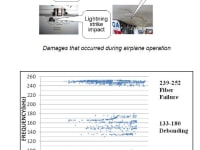INTRODUCTION
Most modern aircraft have made use of composites as major materials in their structures. Figure 1 shows that airbus A350 uses about 53% of composite materials in its construction.It is essential to predict the failure modes and characteristics of such materials. However, the composite materials are quite vulnerable to environmental and external particles and thus non-destructive testing has been the the best option to characterize such materials while retaining their integrity. Most of the NDT tools are not in situ i.e., aircrafts have to be grounded before they could be tested. Although, this method has helped us estimate the presence of already existing defects, we will not be able to predict the damage for real time loads that occurs in various occasions like that of bird hits. Also, it is essential to predict any damge during ‘in-flight’ condition. Considering the rising concern of maintenance costs related to use of composites, it is essential to have a real time system setup to monitor continuously the presence of any newly formed defects during flight. Structural Integrity Monitoring System can be used for this purpose. Figure 2 shows the Damages that occurred during airplane operation and Example to illustrate failure mode characterization of carbon laminate.
Working Principle
Consider a composite laminate made up of Carbon fiber and epoxy matrix. Tatiparthi et al predicted that the damage in composite materials can be divided into the following categories:
i. Fiber/Matrix debonding
ii. Matrix Cracking
iii. Delamination
iv. Fiber Breakage
v. Fiber pull out
vi. Fracture
The above failure modes have a particular type of frequency range. Acoustic emission technique brings out the exact frequency at which the following failure modes occur. Consider the following example; it is a well-known fact that carbon fibers are used in commercial aircraft construction. The above mentioned failures occur at a particular frequency as shown in figure 1. Prior to actual failure, initial pulses are emitted by the specimen. This initial pulse can be sent to the pilot so that he will be able to understand that there is a possibility of formation of a crack in the specimen. He can then take corrective or preventive actions.
The Innovation solves the following problem:
[1] Real time monitoring of composite structures during flight operation
[2] Prevention of a possible accident
[3] Gives information about the ‘weak link’ in the composite structure when subjected to external loading and this may help the designers to develop a better structure with a higher factor of safety
[4] Improve the overall safety of the public
Like this entry?
-
About the Entrant
- Name:Dinesh Manoharan
- Type of entry:teamTeam members:DINESH MANOHARAN
M.MUTHUMANI
R.Prasanna Kumar - Patent status:none





